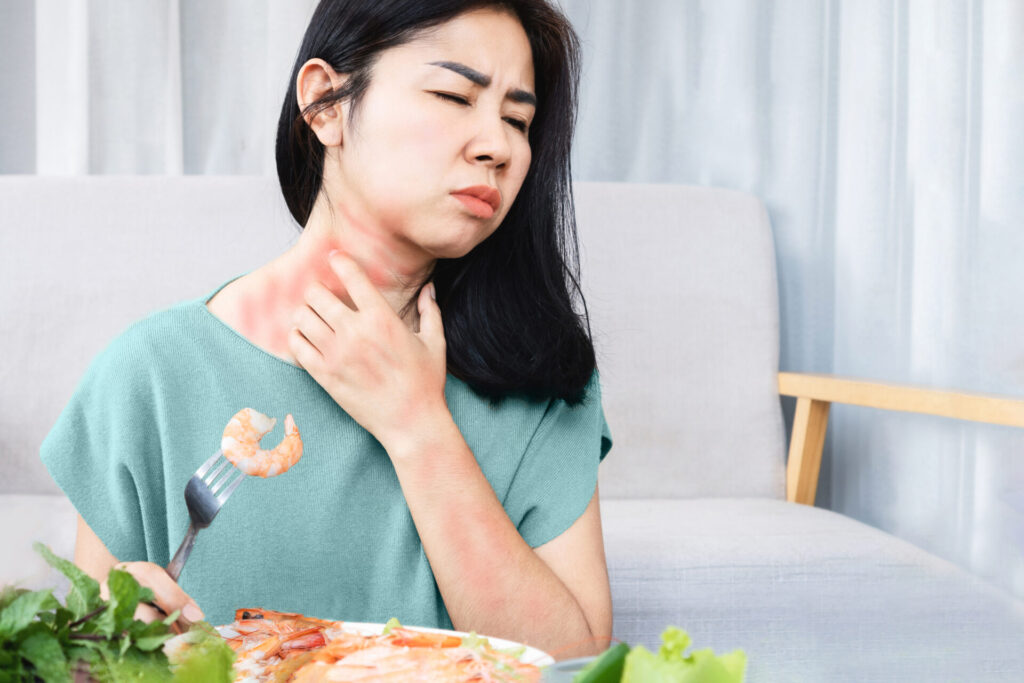Happy Food Allergy Awareness Month! Raising food allergy awareness is a crucial step in helping recognize and identify life-threatening conditions among our friends, family members, and even ourselves. According to FARE (Food Allergy Research and Education), more than 33 million people in the US suffer from a moderate to severe allergy to at least one food trigger, many of whom are allergic to multiple food types and triggers.
Quick Facts About Food Allergies
- A 2019 study showed that 10% of adults and nearly 8% of children in the US suffer from food allergies.
- Roughly 30,000 people visit the ER annually because of a food allergy reaction.
- Up to 200 people die annually from a severe allergic reaction to food.
- Food allergies are on the rise, not just in the US but around the globe. Between 1997 and 2011, the number of patients with food allergies increased by 50% in the US, and the numbers have only risen since.
- In the US, nine major food allergens are recognized: milk, eggs, fish, shellfish, tree nuts, peanuts, wheat, soy, and sesame.
- Shellfish is considered the most common food allergen, followed by milk and peanuts.
- In addition to the top nine, there are over 170 foods that have been reported to cause allergic reactions.
- Roughly half of adults with food allergies say they developed their food allergy or an additional food allergy in adulthood.

Food-Allergy Reactions
There is a range of reactions you can experience with a food allergy. While some people only experience the minor symptoms of oral allergy syndrome, others can reach the life-threatening stage of anaphylaxis.
Oral Allergy Syndrome
Oral Allergy syndrome (OAS) is a type of food allergy response where the patient’s lips, mouth, and tongue experience certain sensations after eating raw fruits, vegetables, nuts, or spices. It does not usually trigger the more severe, full-body allergic reactions that a standard food allergy can cause. However, a small percentage of patients with OAS do develop such reactions after eating their trigger foods.
Symptoms of OAS:
- Itching, tingling, or slight swelling of the lips, tongue, mouth, or throat
- Bumpiness on the lips, tongue, mouth, or throat
- Skin irritation on the hands or any part of the body that touched the trigger food (occasional)
- Development of standard food-allergy reactions (rare)
OAS is the most common food-allergy reaction for adults, and while not everyone with a pollen allergy develops OAS, everyone with OAS also suffers from an allergy to pollen.
Non-Anaphylactic Food-Allergy Reactions
Symptoms of a food allergy can cause pain and discomfort for many patients without leading to dangerous, life-threatening reactions. Some of the most common symptoms of a moderate food allergy include:
- Congestion and difficulty breathing (mild)
- Dizziness or lightheadedness (mild)
- Mouth tingling or itching
- Nausea, vomiting, or diarrhea
- Skin rashes or hive development
- Swollen lips, tongue, throat, or face (mild)
Anaphylaxis
Anaphylaxis is the most extreme reaction your body can have to an allergy trigger. If a patient experiences severe allergic reactions to a food trigger, they may develop:
- Drop in blood pressure
- Extreme congestion or difficulty breathing
- Extreme swelling in the face, mouth, or throat
- Loss of consciousness
- Narrowed or closed airways due to swelling
- Rapid heartbeat
How to Practice Food Safety Throughout Food Allergy Awareness Month (And All Year Round)
Whether you or a loved one suffers from a food allergy, here are some tips to keep yourself, your friend, or your family member safe:
Spread the Word About Your Food Allergy / Be in the Know About Others’ Food Allergies
It’s important to let people know about your food allergies and be aware of other people’s food allergies, especially when snacks or meals are involved.
- Attending a dinner party? Let the host know about your allergies. If you’re planning to bring a dish, be sure to ask if anyone on the guest list has allergies.
- Working in a new office environment? Tell your coworkers about your allergy, and ask if anyone else in your workspace has an allergy you should know about.
- Visiting a restaurant? Let your server know about your food allergy. Many restaurants have special menus designed to serve patrons with food allergies.
Have a Plan for an Allergic Reaction
As diligent as you might be with what you eat, there is always the possibility of consuming a product that incorporates a food trigger. Be sure to have a plan in place to be safe. Plan options can include:
- Always having an epinephrine injector (like an EpiPen) on hand
- Wearing a bracelet that lists out your allergy triggers
- Carrying a medical card that lists out your allergy triggers
- Informing the people you’re with about your typical reaction and what they should do if you experience one
Always Read Food Labels
Food labels have become more scannable and user-friendly. Many clearly define which of the top nine food allergens are present in the product. But it’s still wise to read the ingredients list and look for indicators of cross-contamination, even if the product doesn’t directly include your trigger.
Food allergies can be a challenging condition to navigate. For the best treatment and protection, turn to allergy specialists at Langford Allergy.
Dr. Langford and our team treat all allergies and allergy symptoms, including food allergies. We perform thorough testing to determine the types of foods that cause reactions. We also offer treatments, medications, and education on protecting yourself while dining or snacking.
Schedule an allergy test with our team today: 478-787-4728
Langford Allergy delivers allergy, asthma, and immune deficiency care to patients throughout Middle Georgia, including:
- Macon, GA
- Warner Robins, GA
- Milledgeville, GA
- Forsyth, GA
Related articles:
Eating Well During Food Allergy Awareness Month
How to Introduce New Foods Safely to Babies
